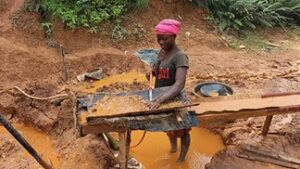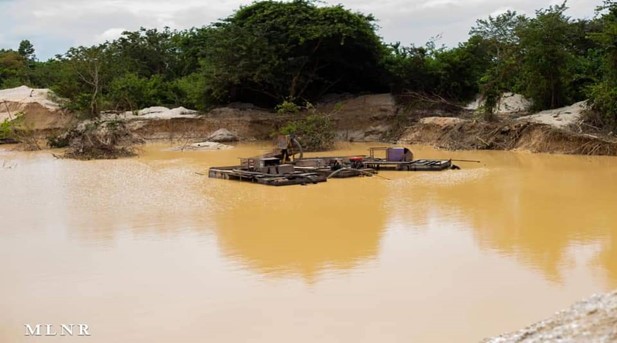The value of Ghana’s gold export receipts for 2022 is estimated to be some US$ 6.6 billion. The amount is over US$1 billion more than the figure realised in 2021 – US$5.083 billion, which was a decline from US$ 6.779 billion recorded in 2020.
This was attributed to the contraction in gold production, particularly the near-collapse in the volume of gold exports by the small-scale sub-sector in 2021.
Furthermore, gross receipts from the export of minerals waned from US$ 6.998 billion in 2020 to US$5.241 billion in 2021, representing a 25 percent drop. However, gold exports in 2022 alone are more than the total minerals export value for the previous year.
The development comes on the back of industry expectation for a 12.5 percent increase in the 2022 year under review as output from large-scale gold producers in the country, against the previous year’s gold production of 2.7 million ounces.
The Minister for Lands and Natural Resources, Samuel Abu Jinapor, at a recent press briefing, in Accra, disclosed that, in the small-scale mining space, gold output went up from 3,429.91kg in 2021 to 22,158.25kg in 2022, representing about 550 percent increase.
These among others demonstrate the significance of the ‘gold sector’ (particularly the small-scale sub-sector which provides an estimated 40 percent of Ghana’s total gold output while employing close to some 1 million people) to the national economy.

A woman artisanal small-scale miner
But, despite this, the small-scale mining sector has been fraught with an age-long illegal practice commonly known as ‘galamsey.’ This menace has since brought the ‘second-tier gold production industry’ into disrepute, in recent years, notably due to its wanton environmental destruction and pollution resulting from the practice.
An illegal mining site
In the face of these challenges, successive governments have tried various interventions, in a bid to end illegal mining which is pervasive in the gold mining regions of the country.
In 2017, the government promised to end the galamsey menace and subsequently halted all small-scale mining operations and launched intensive security operations to clamp down on those involved in illegal mining operations.
But this notwithstanding, the country has yet to witness the end of galamsey activities. At a meeting with the Ghana National Association of Small-scale Miners, Mr. Jinapor said the government remains unrelenting in its efforts to sanitise and regulate the small-scale mining sector.

Sector Minister, Samuel Jinapor, addressing security personnel during a tour of an illegal mining site
“The government is very mindful of the consequential and important nature of the small-scale mining sector of our country,” he said while also acknowledging the challenges.
This is occurring at the time several reformative measures have been initiated to curb the situation, including the introduction of a mercury-free gold processing technology dubbed, the ‘gold katcha.’
The new technology, comprising a crusher, miller, concentrator, and upgrading smelting system, with its operation is envisaged to help eliminate the use of mercury to extract gold from the ore. This follows the adoption of the Minamata Convention on Mercury, which enjoins state parties to take measures to reduce and where feasible, eliminate the use of mercury in artisanal and small-scale mining.
At the inauguration of about 100 of these pieces of equipment, last year, the President, Nana Addo Dankwa Akufo-Addo, said it will significantly help to protect the health and lives of small-scale miners, and the natural environment, and above all, protect the population from the debilitating hazards of mercury use.

Some of the gold katcha equipment inaugurated by President Akufo-Addo
This is because the uncontrolled use and exposure to mercury, aside from contaminating water bodies and destroying aquatic life, can also result in damage to the nervous, digestive, and immune systems of humans.
The President, however, also acknowledged that the small-scale mining sector has been a major vehicle of environmental pollution and land degradation, including the threat posed to life by the use of mercury in the recovery of gold and its subsequent release into the ecosystem.
But he noted that banning small-scale mining cannot be the solution to this challenge. It is against this background that he said several efforts have been made to ensure a viable, responsible and sustainable small-scale mining sector.
Among these efforts, is the Community Mining Scheme, which has been revamped along with an operational manual that has been developed to promote responsible and environmentally-sound small-scale mining?

The policies and strategies being implemented, according to the Ministry in charge of the sector, are to promote viable businesses for Ghanaians who intend to work in the mining industry while protecting the environment.
“This is part of the broader vision of the government to make Ghana the mining hub of Africa, where all mining and mining-related activities from exploration to downstream production, and from innovation to research, will be centred,” the Minister stated at the ceremony.
The Communications Director of the Ghana National Association of Small-scale Miners, Abdul Razak Alhassan, in an interview, expressed his satisfaction with the new technology.
He highlighted the effectiveness of the gold katcha, stating that it allows miners to retrieve around 90 percent of the gold, compared to the previous method’s yield of only 30 to 40 percent.
Meanwhile, he lauded the Minerals Commission for digitizing its services, while noting that moving it online makes it easier for the acquisition and application of mining licenses.










